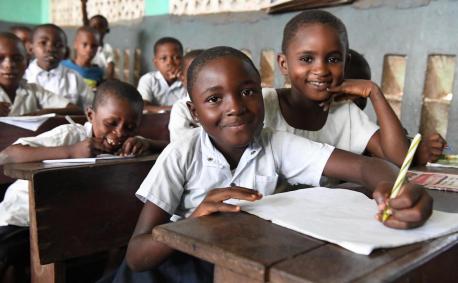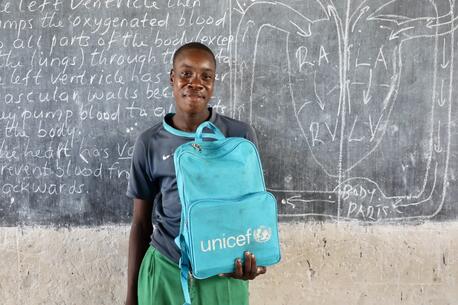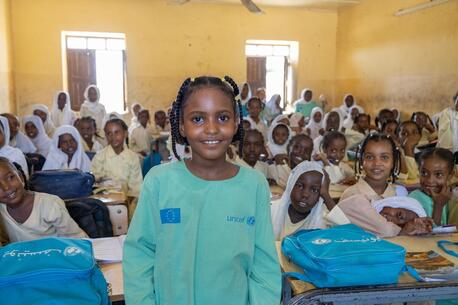
UNICEF Urges Action to Transform Education, End Learning Poverty
How severe is the global learning crisis? Only a third of all 10-year-olds are able to read and understand a simple written story.
As a result of the worst shock to education and learning in recorded history, learning poverty has sharply increased in low- and middle-income countries, with 64 percent of children estimated to be unable to read and understand a simple written story by age 10, according to the latest data.
Another new UNICEF report shows that girls worldwide are lagging behind boys in mathematics — with sexism and gender stereotypes held by teachers, parents and peers regarding girls' abilities among the leading contributors to the learning disparity.
Globally, an estimated 502 million children are in learning poverty
To be clear: the pandemic did not cause this global learning crisis; but it did make it worse. Before COVID-19 disrupted schooling for 1.6 billion students worldwide, there were hundreds of millions of children lacking basic literacy and numeracy skills.
Vulnerable children are the most affected. Children in low-income countries are around seven times less likely to reach minimum reading proficiency by age 10 than children of the same age in high-income countries.
Learning deficits are a major driver of intergenerational poverty and inequality, so the learning crisis is about much more than individual achievement; it is also widely viewed as a threat to global and national development, growth and prosperity. An estimated $17 trillion in potential lifetime earnings are at risk.

To draw attention to the education crisis and the need to transform learning worldwide, UNICEF unveiled the ‘Learning Crisis Classroom’ installation at United Nations Headquarters in New York, where UNICEF is hosting a three-day Transforming Education Summit. The desks made of a clear material represent the 64 percent of children estimated to lack minimum proficiency in reading comprehension. © UNICEF/UN0703306/Chris Farber/UNICEF via Getty Image
“Under-resourced schools, underpaid and under-qualified teachers, over-crowded classrooms and archaic curricula are undermining our children’s ability to reach their full potential,” UNICEF Executive Director Catherine Russell said. “The trajectory of our education systems is, by definition, the trajectory of our future. We need to reverse current trend lines or face the consequences of a failing to educate an entire generation. Low levels of learning today mean less opportunity tomorrow.”
In the lead-up to a three-day summit in New York, UNICEF renewed its call for urgent action toward learning recovery and education transformation in order to avert a generational catastrophe.
It is not enough simply to reopen schools. Children, especially the most marginalized and those children affected by emergencies, need additional support to catch up and progress and to ensure their continued ability to learn.

On March 6, 2022 in Mosul, Iraq, students line up to return to class at the UNICEF-supported Al-Hamideen School. © UNICEF/UN0613722/Ibarra Sánchez
Specifically, UNICEF is calling on governments to commit to reaching all children with quality education — urging new effort and investment to re-enroll and retain all children in school, to increase access to remedial and catch-up learning, to support teachers and give them the tools they need, and to make sure that schools provide a safe and supportive environment so all children are ready to learn.
Recent studies of the impacts of pandemic-related school closures have concluded that many countries need to accelerate efforts in all of these key areas in order to address learning loss and advance progress toward the global Sustainable Development Goals (SDG) for education. (SDG target 4.1: "By 2030, ensure that all girls and boys complete free, equitable and quality primary and secondary education leading to relevant and effective learning outcomes.")

Paula, a student at UNICEF-supported Yosiba Elementary School in Simporo, Papua Province, Indonesia, raises her hand in class on June 15, 2021. © UNICEF/UN0506301/Ijazah
UNICEF's March report on education recovery efforts found that less than half of countries surveyed were implementing learning recovery strategies at scale to help children catch up on what they’ve missed; that only half of low-income countries had a plan in place to assess the learning levels of students who have returned to school; and that the share of resources allocated for education had declined during the pandemic in both the official development assistance and humanitarian aid.
From Learning Recovery to Education Transformation, a new joint report by UNESCO, UNESCO Institute for Statistics (UIS), UNICEF, The World Bank and The OECD, details how many countries are still not taking targeted and proven steps to ensure every child learns.
The good news is that there are solutions available, and at a relatively low cost: it is estimated that it will take just $10 to $15 per child to deliver remedial education and strengthen existing education systems’ ability to deliver on foundational skills.

Sundus Moleameed Alimed, left, teaches 3- and 4-year-old pre-primary school students how to count to 10 in Arabic through a song they sing back to her. The children are benefiting from a UNICEF-supported community education program in Puntland state, Somalia. © UNICEF/UN0635371/Hill
Ensuring foundational literacy and math skills are critical for learning recovery
Ensuring that every student gains a solid foundation in basic reading and mathematics — key skills children need to build their futures, and those of their families and communities — is a priority. Without these basic skills, students are unable to recover lost learning, are not prepared to transition to secondary education and, ultimately, will struggle to find success in the workplace.
In accounting, assessing and accelerating learning, UNICEF advocates that governments take a back-to-the-basics approach and ensure a sharp focus on basic reading and mathematics.
UNICEF supports the 'RAPID' framework for addressing the learning crisis
UNICEF is urging every government to endorse the 'RAPID' agenda and commit to its five critical action items, which are:
Reach and retain every child in school
Assess learning levels
Prioritize teaching the fundamentals
Increase catch-up learning and progress beyond what was lost
Develop psychosocial health and well-being so every child is ready to learn
A few examples of best practices:
Indonesia: Through tailored instruction, teacher capacity development and community engagement in Papua Province, Indonesia was able to improve literacy rates in its lower-performing schools; the proportion of nonreaders dropped from 62 percent to 26 percent and the pool of adequate readers increased from 6 percent to 18 percent in targeted schools.
Nigeria: After the implementation of a program in Maiduguri, Borno State, called Teaching at the Right Level — where instruction is given in Hausa, the local language — the percentage of children in grades 4 to 6 who could read a paragraph increased from 14 percent to 45 percent.
India: Community-based in-person lessons led by volunteer teachers (often parents) reached 60,000 primary-aged children who would otherwise miss out, due to a lack of access to digital learning; SMS messages containing simple learning activities parents could help children complete at home reached 56,000 primary-aged children in the tea gardens of Assam, one of the most marginalized groups.
Learn more about the global learning crisis and UNICEF-supported strategies for addressing it. Read The State of Global Learning Poverty: A 2022 Update.
UNICEF is at the forefront of promoting simple and effective methods to advance foundational learning – basic reading and math skills. Help UNICEF tackle the global learning crisis head on — and help create a world where every child has equal access to quality education. Donate today.
TOP PHOTO: Children attend class at a UNICEF-supported school in Mbandaka, in the Equatorial Province of the Democratic Republic of the Congo. © UNICEF/UN0507549/Dejongh
HOW TO HELP
There are many ways to make a difference
War, famine, poverty, natural disasters — threats to the world's children keep coming. But UNICEF won't stop working to keep children healthy and safe.
UNICEF works in over 190 countries and territories — more places than any other children's organization. UNICEF has the world's largest humanitarian warehouse and, when disaster strikes, can get supplies almost anywhere within 72 hours. Constantly innovating, always advocating for a better world for children, UNICEF works to ensure that every child can grow up healthy, educated, protected and respected.
Would you like to help give all children the opportunity to reach their full potential? There are many ways to get involved.





